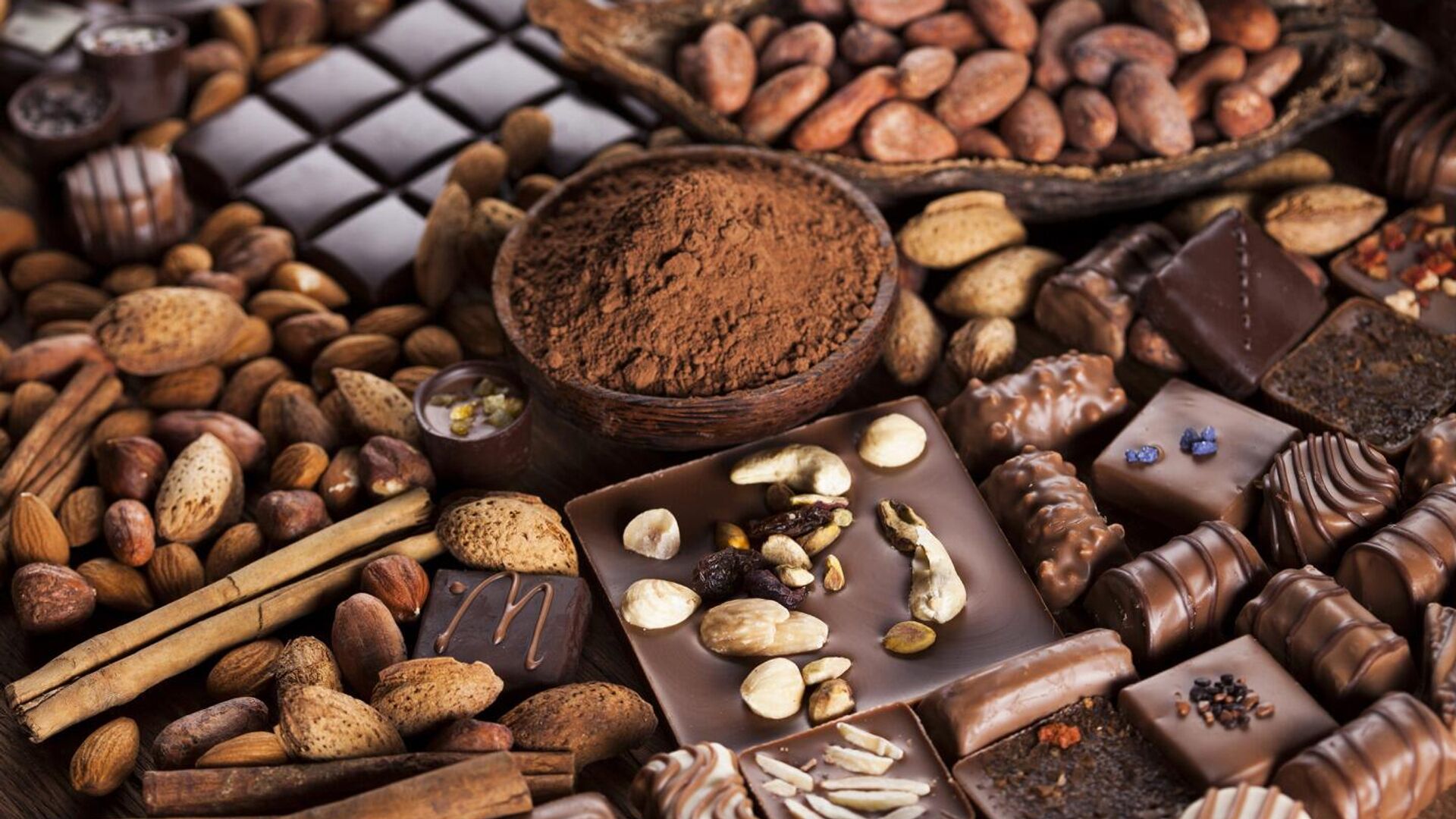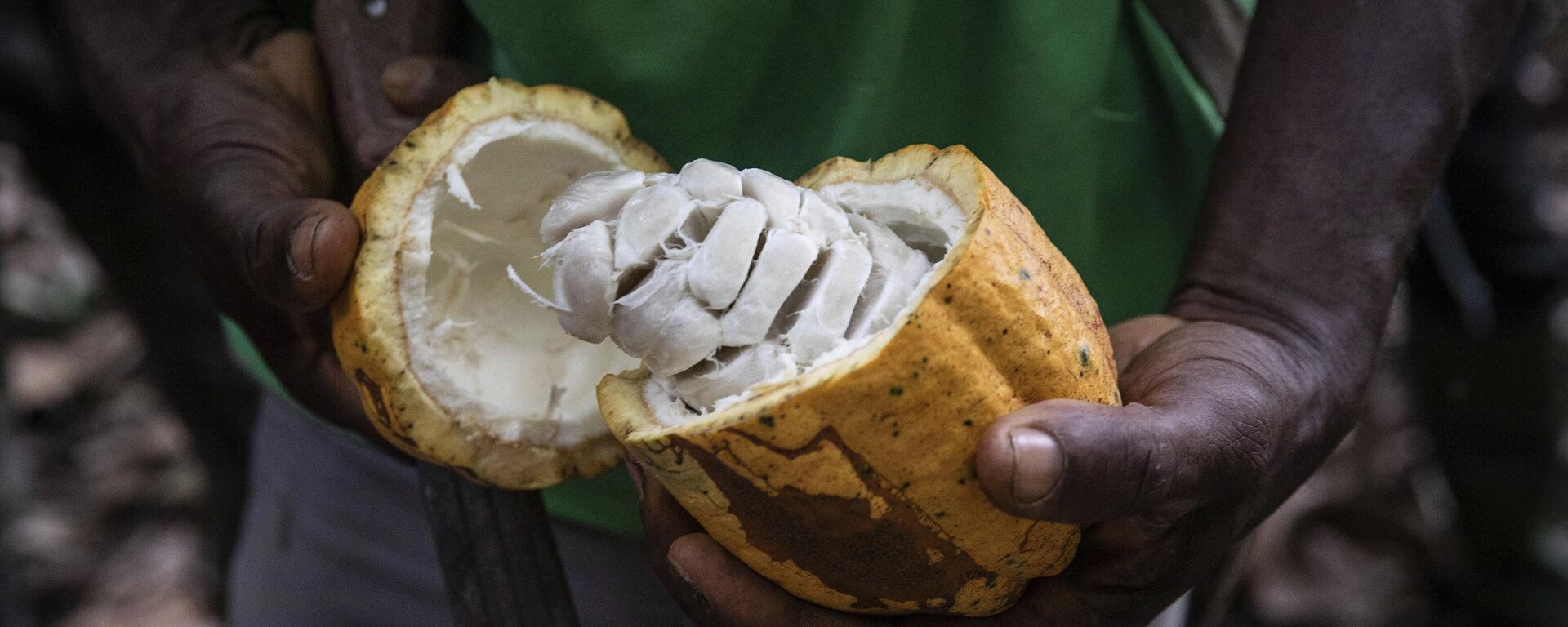https://en.sputniknews.africa/20240331/what-caused-price-of-cocoa-beans-to-rise-and-what-can-it-lead-to-1065850356.html
What Caused Price of Cocoa Beans to Rise and What Can It Lead to?
What Caused Price of Cocoa Beans to Rise and What Can It Lead to?
Sputnik Africa
The International Cocoa Organization (ICCO) reported in January that the two-year global cocoa bean deficit will continue into 2024, while shipping... 31.03.2024, Sputnik Africa
2024-03-31T14:33+0200
2024-03-31T14:33+0200
2024-03-31T14:33+0200
economy
ghana
european union (eu)
united states (us)
chocolate
cocoa
west africa
features
https://cdn1.img.sputniknews.africa/img/07e8/03/1f/1065851968_0:45:1440:855_1920x0_80_0_0_8edf62ff946a40f1576d13e28d3cd7a9.jpg
The price of cocoa beans, already on a steady rise over the past two years, surged to unprecedented levels in March, surpassing $10,000 per tonne for the first time in history, increasing by 2.4 times since the beginning of the year.In early February, the exchange value of a tonne of cocoa beans for the first time since 1977 was $5,000 dollars, and less than a week later, prices increased to $5,500 dollars per ton, exceeding the record of 47 years ago.According to the International Cocoa Organization, production is expected to fall short of demand by 374,000 tonnes by 2024, while Swiss-based producer Barry Callebaut expects a gap of about 500,000 tonnes, or about one-tenth of the global market.What are the reasons for this price increase, and what does it entail?The higher cocoa prices are due to low crop yields in West Africa, where approximately 70% of the world's cocoa is grown. The low yields are caused by the El Niño weather phenomenon, an above-average sea surface temperature in the Pacific Ocean that affects global climatic conditions, causing higher temperatures and heavy rains in the region.The ICCO cited "unseasonal heavy rains" as the main reason for the deterioration of cocoa supplies late last year, noting that these heavy rains led to the spread of a fungal infection called black pod disease.The disease affects the pods, roots, stems, shoots, and flower cushions of cocoa trees, causing the beans to rot internally. It usually occurs during the rainy season and spreads when rain hits the plants.In particular, according to the organization, there has been a shortage of supply from key producers in Côte d'Ivoire and Ghana, which has led to a 28% and 35% drop, respectively, in arrivals at these countries' ports compared to the previous season.In addition, media reports indicate that financial factors are also responsible for the price hike. Traders, accustomed to using futures contracts to hedge risk, have found themselves overwhelmed by the rapid and unidirectional movement of prices. Attempts to mitigate risk through short positions have only exacerbated the situation, leading to further price increases, the media reported.Furthermore, pending European Union rules banning trade in products linked to deforestation, which "will act as a ban on cocoa exports from Ghana and Côte d'Ivoire to the European Union," could exacerbate the cocoa shortage, Dr. Tafadzwa Ruzive, a development finance expert from South Africa's Nelson Mandela University, told Sputnik Africa.In its quarterly update on February 29, the ICCO forecast world cocoa stocks for 2023-24 at 4.449 million tonnes, down 11% from 2022-23. The organization also raised its forecast for the current season's world cocoa deficit to 374,000 metric tons, significantly higher than the 74,000 metric tons deficit ICCO forecast for 2022-23.According to Western media reports, chocolate companies are coping with the shortage by reducing packaging, using automation to cut production costs, and promoting products with less cocoa or other basic flavorings. For example, US-based Mars has reportedly resorted to reducing the size of its chocolates while selling them at the same price.Major US chocolate makers Hershey and Mondelez said they will raise prices to cover the rising cost of cocoa, meaning consumers will pay more for chocolate in stores.At the same time, Brazilian, Ecuadorian, Cameroonian, and Nigerian farmers are reportedly increasing bean production. However, it takes several years for beans to germinate, so the countries' efforts will not make up the shortfall in the short term.
https://en.sputniknews.africa/20240328/cocoa-crisis-looms-as-global-prices-skyrocket--eu-regulations-threaten-african-producers-expert-1065810911.html
ghana
united states (us)
west africa
Sputnik Africa
feedback@sputniknews.com
+74956456601
MIA „Rossiya Segodnya“
2024
Maxim Grishenkin
https://cdn1.img.sputniknews.africa/img/07e7/0a/17/1063018107_0:0:1104:1103_100x100_80_0_0_03090c85a11f5d2e8a19cf1d989443c9.jpg
Maxim Grishenkin
https://cdn1.img.sputniknews.africa/img/07e7/0a/17/1063018107_0:0:1104:1103_100x100_80_0_0_03090c85a11f5d2e8a19cf1d989443c9.jpg
News
en_EN
Sputnik Africa
feedback@sputniknews.com
+74956456601
MIA „Rossiya Segodnya“
Sputnik Africa
feedback@sputniknews.com
+74956456601
MIA „Rossiya Segodnya“
Maxim Grishenkin
https://cdn1.img.sputniknews.africa/img/07e7/0a/17/1063018107_0:0:1104:1103_100x100_80_0_0_03090c85a11f5d2e8a19cf1d989443c9.jpg
economy, ghana, european union (eu), united states (us), chocolate, cocoa, west africa
economy, ghana, european union (eu), united states (us), chocolate, cocoa, west africa
What Caused Price of Cocoa Beans to Rise and What Can It Lead to?
The International Cocoa Organization (ICCO) reported in January that the two-year global cocoa bean deficit will continue into 2024, while shipping difficulties in the Red Sea will support the current trend of rising prices for the commodity.
The price of cocoa beans, already on a steady rise over the past two years, surged to unprecedented levels in March, surpassing $10,000 per tonne for the first time in history, increasing by 2.4 times since the beginning of the year.
In early February, the exchange value of a tonne of cocoa beans for the first time since 1977 was $5,000 dollars, and less than a week later, prices
increased to $5,500 dollars per ton, exceeding the record of 47 years ago.
According to the International Cocoa Organization, production is expected to fall short of demand by 374,000 tonnes by 2024, while Swiss-based producer Barry Callebaut expects a gap of about 500,000 tonnes, or about one-tenth of the global market.
What are the reasons for this price increase, and what does it entail?
The higher cocoa prices are due to low crop yields in West Africa, where approximately 70% of the world's cocoa is grown. The low yields are caused by the El Niño weather phenomenon, an above-average sea surface temperature in the Pacific Ocean that affects global climatic conditions, causing higher temperatures and heavy rains in the region.
The ICCO cited "unseasonal heavy rains" as the main reason for the deterioration of cocoa supplies late last year, noting that these heavy rains led to the spread of a fungal infection called black pod disease.
The disease affects the pods, roots, stems, shoots, and flower cushions of cocoa trees, causing the beans to rot internally. It usually occurs during the rainy season and spreads when rain hits the plants.
"Some industry sources believe the sharp decline may signal a structural change from cocoa beans to palm as there is no cure for the viral cocoa tree disease and land can’t be replanted for five years after the infected trees are removed," the ICCO pointed out.
In particular, according to the organization, there
has been a shortage of supply from key producers in Côte d'Ivoire and Ghana, which has led to a 28% and 35% drop, respectively, in arrivals at these countries' ports compared to the previous season.
In addition, media reports indicate that financial factors are also responsible for the price hike. Traders, accustomed to using futures contracts to hedge risk, have found themselves overwhelmed by the rapid and unidirectional movement of prices. Attempts to mitigate risk through short positions have only exacerbated the situation, leading to further price increases, the media reported.
Furthermore, pending European Union rules banning trade in products linked to deforestation, which "will act as a ban on cocoa exports from Ghana and Côte d'Ivoire to the European Union," could exacerbate the cocoa shortage, Dr. Tafadzwa Ruzive, a development finance expert from South Africa's Nelson Mandela University, told Sputnik Africa.
In its quarterly update on February 29, the ICCO forecast world cocoa stocks for 2023-24 at 4.449 million tonnes, down 11% from 2022-23. The organization also raised its forecast for the current season's
world cocoa deficit to 374,000 metric tons, significantly higher than the 74,000 metric tons deficit ICCO forecast for 2022-23.
According to Western media reports, chocolate companies are coping with the shortage by reducing packaging, using automation to cut production costs, and promoting products with less cocoa or other basic flavorings. For example, US-based Mars has reportedly resorted to reducing the size of its chocolates while selling them at the same price.
Major US chocolate makers Hershey and Mondelez said they will raise prices to cover the rising cost of cocoa, meaning consumers will pay more for chocolate in stores.
At the same time, Brazilian, Ecuadorian, Cameroonian, and Nigerian farmers are reportedly increasing bean production. However, it takes several years for beans to germinate, so the countries' efforts will not make up the shortfall in the short term.



